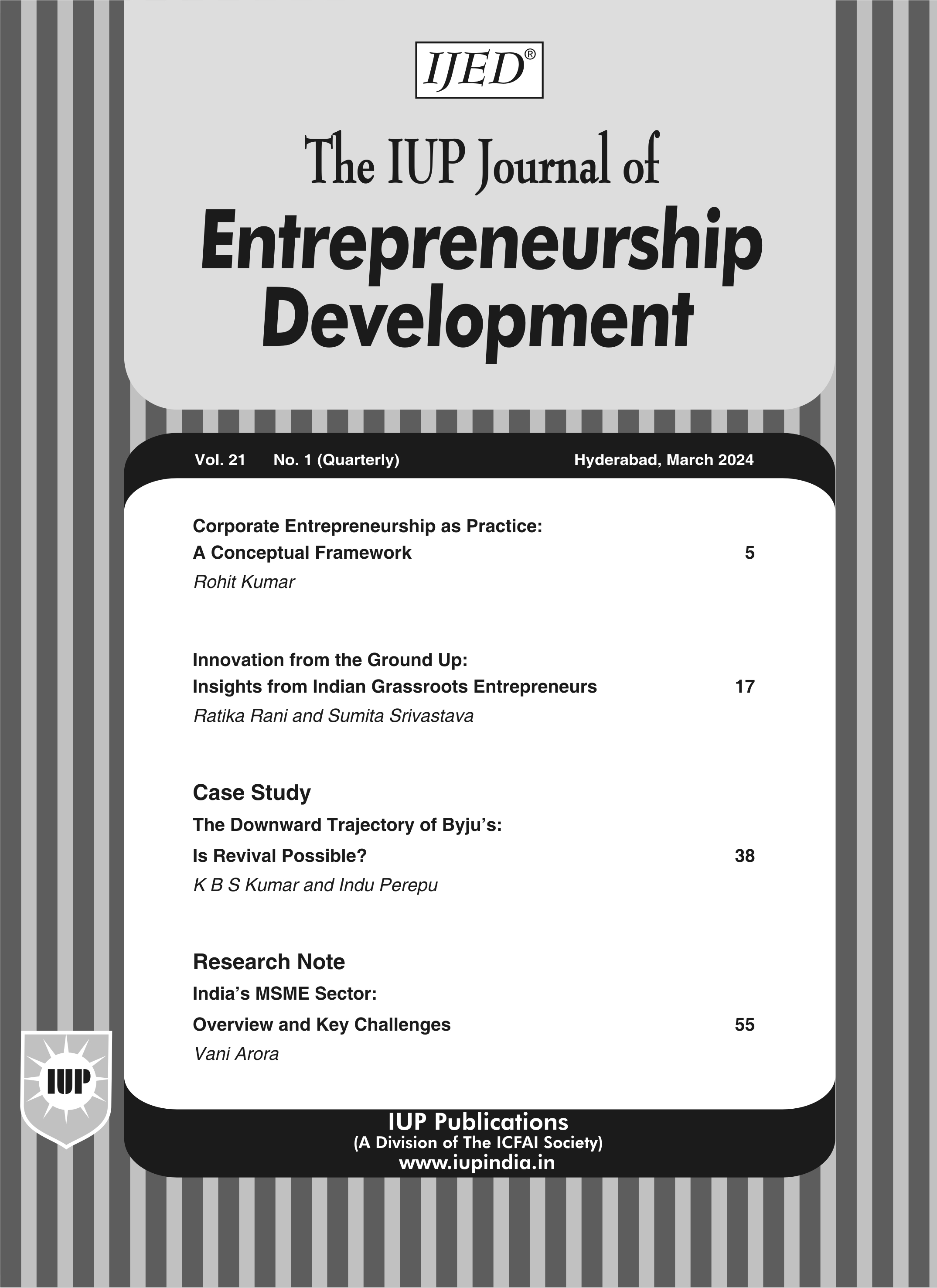
June'21
The IUP Journal of Entrepreneurship Development
Archives
Performance Evaluation of Entrepreneurship Development Schemes of National Handicapped Finance and Development Corporation
Shanimon S
Assistant Professor of Commerce, Government College Attingal, University of Kerala, Thiruvananthapuram,
Kerala, India; and is the corresponding author. E-mail: shanimonimon@gmail.com
Shalini Lawrence
Assistant Professor of Economics, Government College Attingal, University of Kerala, Thiruvananthapuram,
Kerala, India. E-mail: maryshalinilawrence@gca.ac.in
The growth and development of all economies highly depend on entrepreneurial activity. Entrepreneurs are the nerves of economic development as they provide a source of income and employment. They create an atmosphere of employment generation for others, and produce new and innovative products and services. Entrepreneurial supportive environment is essential for entrepreneurship development and is evolving in the developing economies. An entrepreneurial environment has five metrics, namely, easy access to funding, entrepreneurial culture, entrepreneurial supportive regulatory measures, entrepreneurial supportive mechanism and entrepreneur-friendly policies. The public and the private sectors have an equal role to play in the development of entrepreneurial ecosystem. There are four factors necessary for entrepreneurial opportunities namely, factor-driven entrepreneurship, efficiency-driven entrepreneurship, innovation-driven entrepreneurship and necessity-driven entrepreneurship. Entrepreneurship has been considered as the backbone of economic growth. The level of economic activities of a country largely depends on the level of entrepreneurial activities in that country. Entrepreneurs are not born but can be created and nurtured through appropriate interventions in the form of entrepreneurship development programs. In the modern competitive world, a number of opportunities have emerged from the evolving Information Technology (IT) revolution. A large part of the population generally lags behind in taking advantage of the emerging IT revolution. Therefore, there is a need to provide skill development through entrepreneurship development to such people in order to bring them into the mainstream of economic development.
Introduction
Entrepreneurship development programs should be designed to upgrade existing skills and
create new skills by organizing various technical training courses in the mainstream society
(Lindsay et al., 2009). Specific tailor-made programs should be designed for the skill
development of the socially disadvantaged groups, especially for women, persons with
disabilities, scheduled tribes and scheduled castes. Entrepreneurship development and training are the key elements of social and economic development among socially disadvantaged
(Russell et al., 2005; Rakesh and Pandit 2013; and Saeed et al., 2014) groups. To undertake
these tasks on a regular basis, a number of national level entrepreneurship development
institutes and autonomous bodies have been set up in India. These institutes are providing
assistance in funding, entrepreneurship development training, research and consultancy
services. National Handicapped Finance and Development Corporation (NHFDC) is one
among such agencies that provide a number of assistance and program for entrepreneurship
development of the differently abled persons.
National Handicapped Finance and Development Corporation - Profile
NHFDC is the apex level institution promoted by the Ministry of Social Justice and
Empowerment, Government of India. The corporation was incorporated as a company in 1997
under Section 25 of the Indian Companies Act, 1956 to provide financial support to
handicapped people for entrepreneurship development. It provides a number of programs for
entrepreneurship development among the differently abled people. The corporation is mainly
engaged in financial assistance to differently abled persons with minimum 40% of disability
under microfinance schemes. NHFDC undertakes entrepreneurship development programs in
connection with nationalized banks and other specialized institutions.
NHFDC is a specialized institution in the field of entrepreneurship development, especially
for the disabled people with the support of Government of India. NHFDC has been actively
engaged in organizing entrepreneurship development training programs that are beneficial to
the differently abled persons in India.
Objective
The objective of the paper are as follows:
- To help and support differently abled persons in carrying out training and entrepreneurship development programs;
- Promoting economic growth and self-employment ventures for the benefit of differently abled persons;
- Providing financial assistance for persons with disabilities for the development of their entrepreneurial skill;
- Providing loan to persons with disabilities for professional or technical education leading to vocational rehabilitation and self-employment;
- Assisting self-employed persons with disability in marketing their products and for efficient management of self-employment ventures;
- To serve as the apex national level body for accelerating the process of entrepreneurship development programs among differently abled people in India;
- To provide financial assistance to differently abled persons to start business venture;
- To share experience and expertise in entrepreneurial development across the national frontiers through nodal agencies; and
- To provide scholarship assistance to handicapped students.
Schemes Offered by NHFDC
NHFDC has framed various schemes to assist differently abled persons. The schemes mainly involve credit based as well as non-credit based activities for the benefit of differently abled persons. These schemes are mainly implemented through nodal agencies such as State Channelizing Agencies (SCAs).
Credit Based Schemes
The credit based schemes include financial assistance to the person with disabilities fulfilling the eligibility criteria in the form of concessional loans on convenient terms for setting up of income-generating activity.
Non-Credit Based Schemes
Non-credit based schemes are mainly intended for increasing the entrepreneurial talents of differently abled people. These schemes are:
- Grant for conducting or sponsoring the entrepreneurial training under the scheme of "Financial Assistance for Skill and Entrepreneurial Development".
- Schemes for sponsoring the entrepreneurs to conduct various exhibitions and trade fairs.
- Conducting workshops, seminars and conferences.
Performance Evaluation of Various Schemes Offered by NHFDC
NHFDC has continually improved on disbursement of loans. Annual disbursement of loans for the benefit of differently abled persons in the past 24 years (1997 to 2021) show an increasing trend. The progress has been achieved in both the number of beneficiaries and the amount of loan disbursed.
Year-Wise Achievements
Table 1 shows the details of loan sanctioned in credit-based schemes, amount of loan distributed and the total number of beneficiaries under credit-based schemes for a period of 24 years from the period of inception of NHFDC (1997-2021). The Corporation aims at extending the number of beneficiaries under these schemes to achieve its main objectives. In the year 2015-2016 constitute the highest number of beneficiaries from among the total period, and the total number of beneficiaries in that year constitute 20,552. The amount of loan disbursed in the year 1997-1998 was 25.55 lakh in the inception stage and in the year 2020- 2021, total amount disbursed was 13,361.81 lakh, the highest amount of disbursement from among the 24 years. Table 1 and the Figure 1 shows that the corporation has been in a path of development to achieve its objectives and actively engaged in organizing entrepreneurship development programs which have been beneficial to differently abled persons in India.
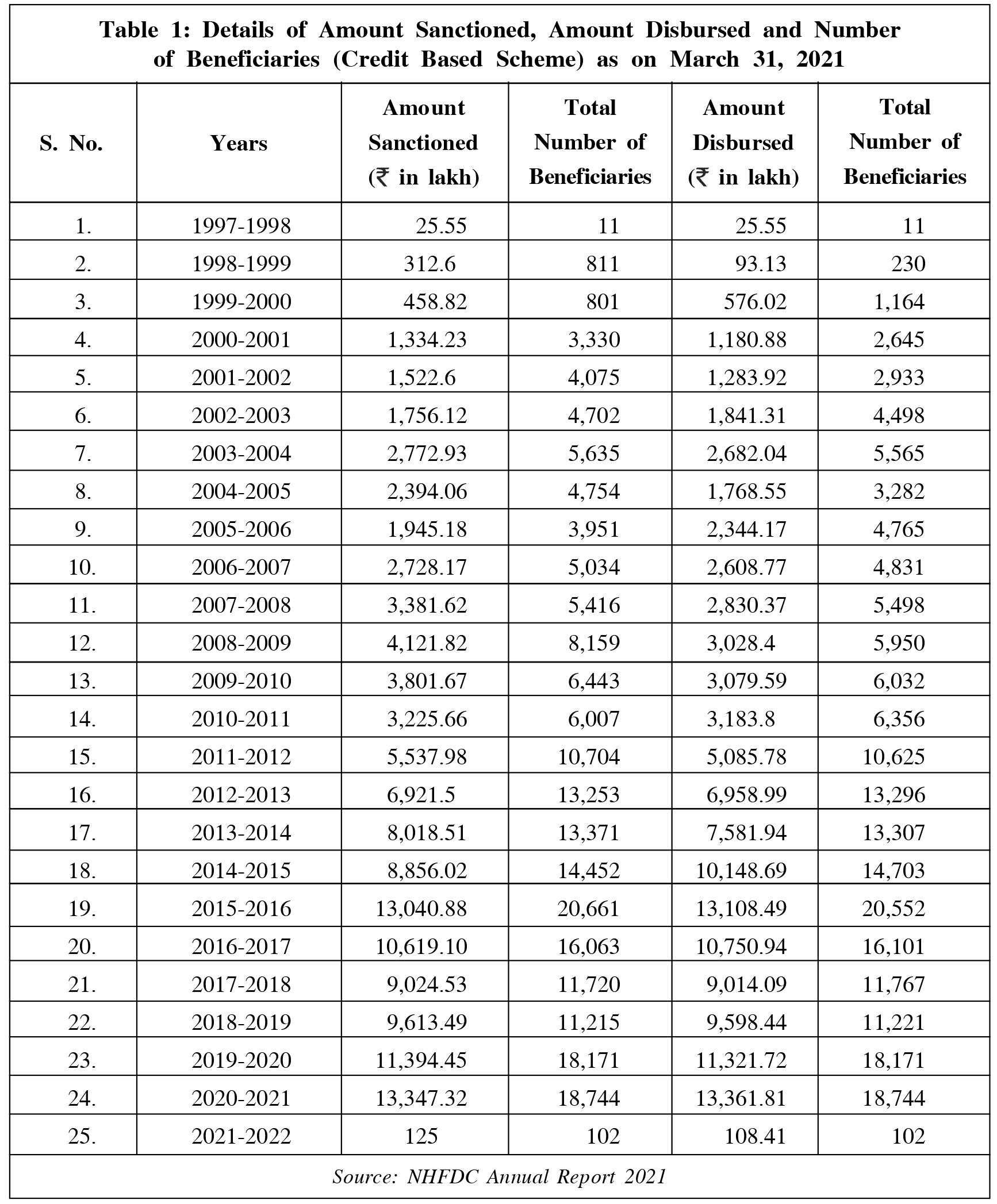
Regression analysis shows that the regression coefficient of 270.07 with R2 value of 0.7932, implying that the regression coefficient is higher in terms of amount disbursed. The growth rate is very high in terms of amount of loan disbursed. The results show that the institution is specialized in the field of entrepreneurship development among differently abled people with the support of Government of India and other non-governmental agencies. The growth rate is very high in term of amount of loan disbursed. The result shows that the institution is specialized in the field entrepreneurship development among differently abled people with the support of Government of India and other non-governmental agencies.
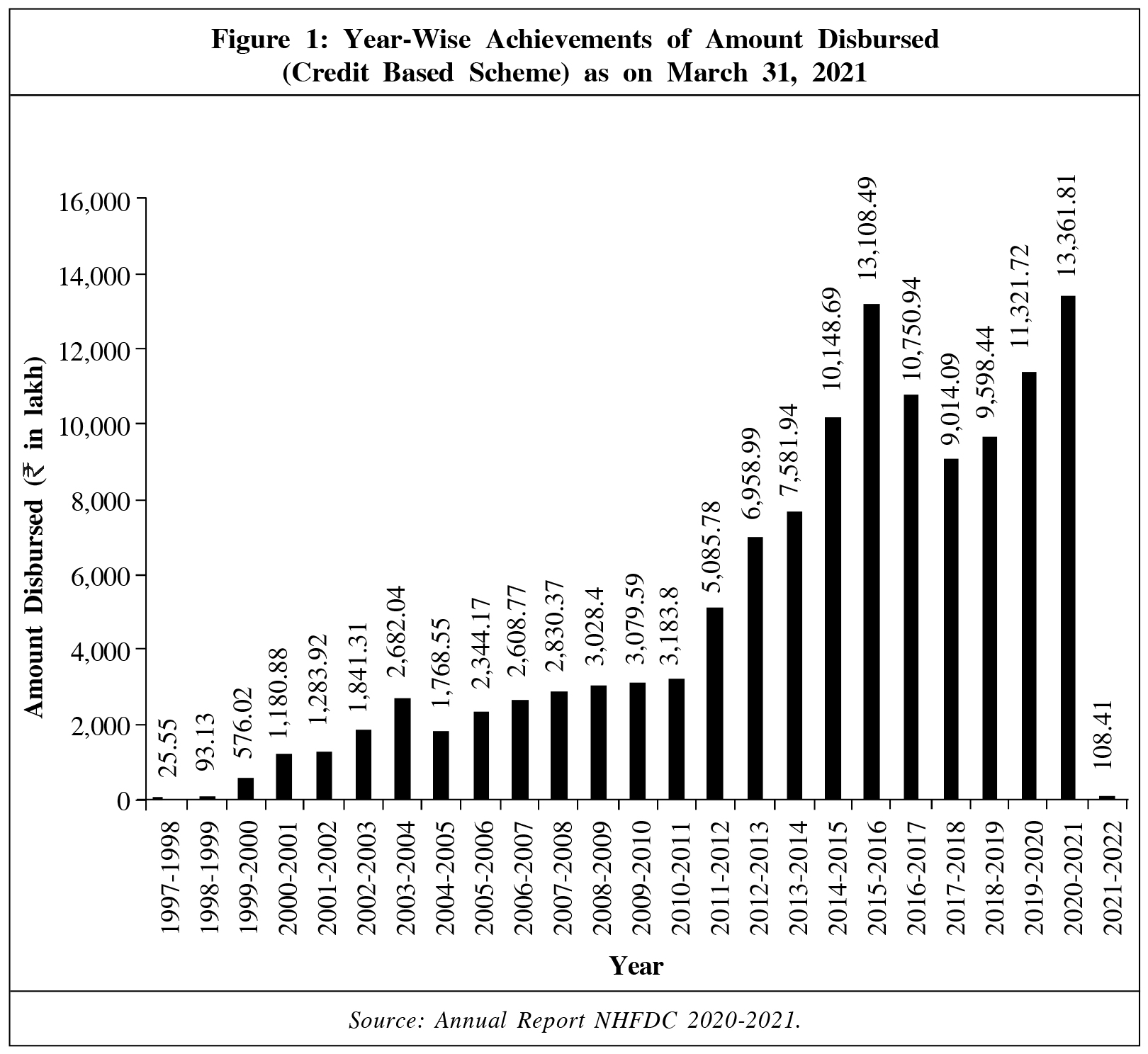
The Corporation aims at extending financial and entrepreneurial assistance to beneficiaries
under credit based and non-credit based schemes for the achievement of its objectives. During
the period of 2015-2016, the corporation attained a highest number of beneficiaries constitute
20,552. In the initial period the number of beneficiaries was negligible, during the inception
stage of this institution, the number of beneficiaries was very low. The corporation attained its
objectives through a long period in terms of coverage of beneficiaries under various schemes
of the Corporation. Last 25 years the corporation has attained a remarkable growth in the area
of entrepreneurship development among differently abled persons both in the terms of total
amount of loan sanctioned and increasing number of beneficiaries (Figure 2).
Further, regression shows that the regression coefficient 834.58 with an R2 value of 0.357,
implying that the regression coefficient is higher in terms of actual number of beneficiaries.
The growth rate is very high in term of actual number of beneficiaries, who have received
the amount of loan to start their business ventures. The above data shows that the number
of beneficiaries who have received financial assistance from NHFDC from the period of
1997-98 to 2015-16 was increased from 11 to 20,552 during the period and the total number
of beneficiaries constitutes 202,247 till 2020-21 in the whole period 24 years. In the initial
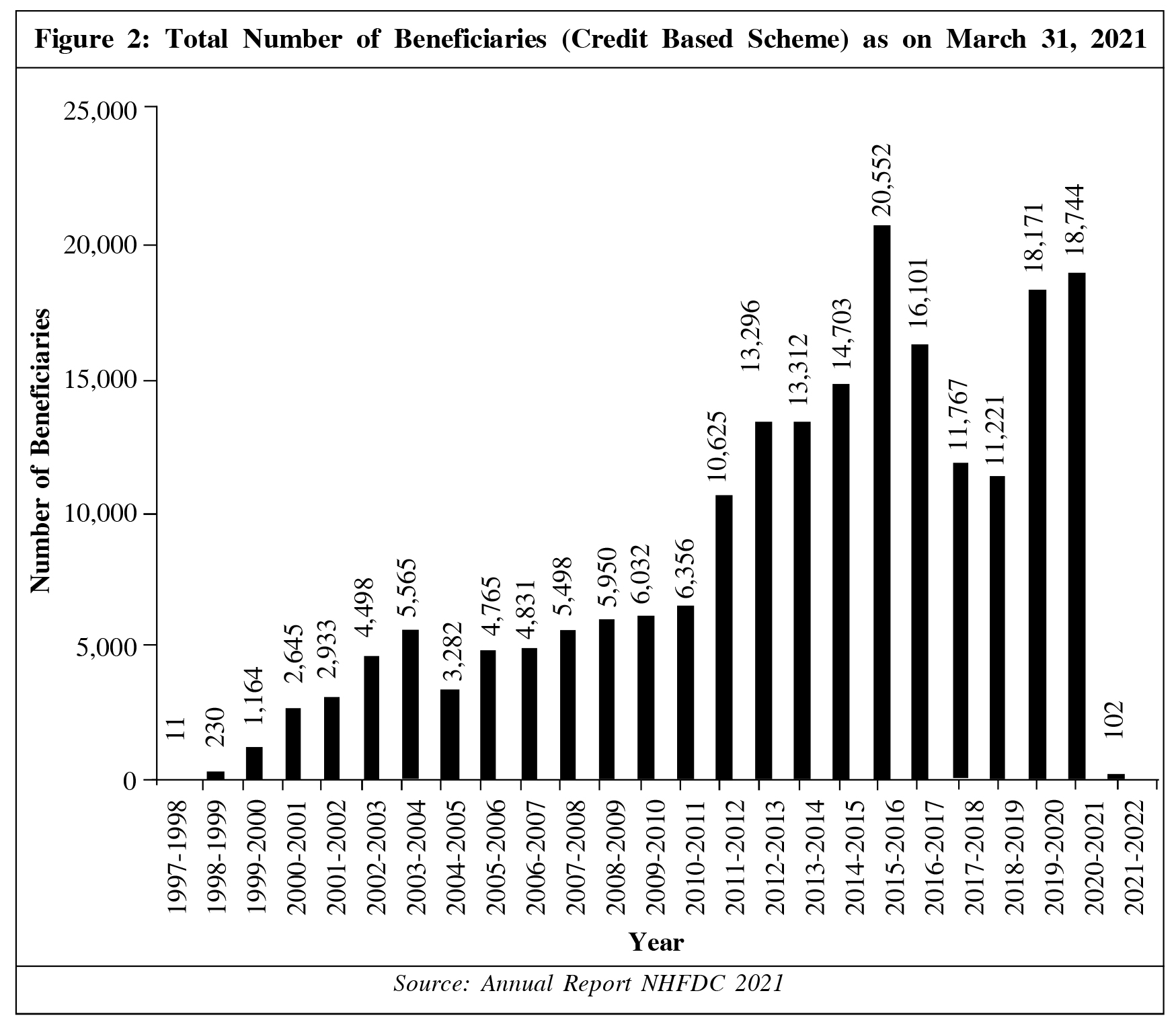
period the number of beneficiaries was negligible and in the period of 2015-16 the number
of beneficiaries was maximum at 20,552.
State-Wise Achievements
Table 2 shows the state-wise details of projects sanctioned and the amount of disbursement
made till 2014. The status of the corporation has continually improved on project sanctioning
and the disbursement of loans to beneficiaries over the past years. Annual disbursement of
loans for the benefit of persons with disabilities in the past years shows that the corporation
was totally focused on entrepreneurship development among differently abled persons. The
top three states in terms of loan offtake from the corporation were Maharashtra, Tamil Nadu
and Haryana. Bihar, Mizoram and Goa were the least in terms of loan offtake from the
corporation and loan distributed among the beneficiaries.
Table 3 shows that the amount of grant sanctioned, number of Entrepreneurship Development
Programme (EDP) sanctioned and the number of total trainees and number of EDPs made up to
2015. The grant was sanctioned for entrepreneurship development training and skill
development to 30 states and UTs in India. The state of Uttar Pradesh conducted the highest
number of EDPs and thereby the highest number of trainees. State of Manipur conduct only one
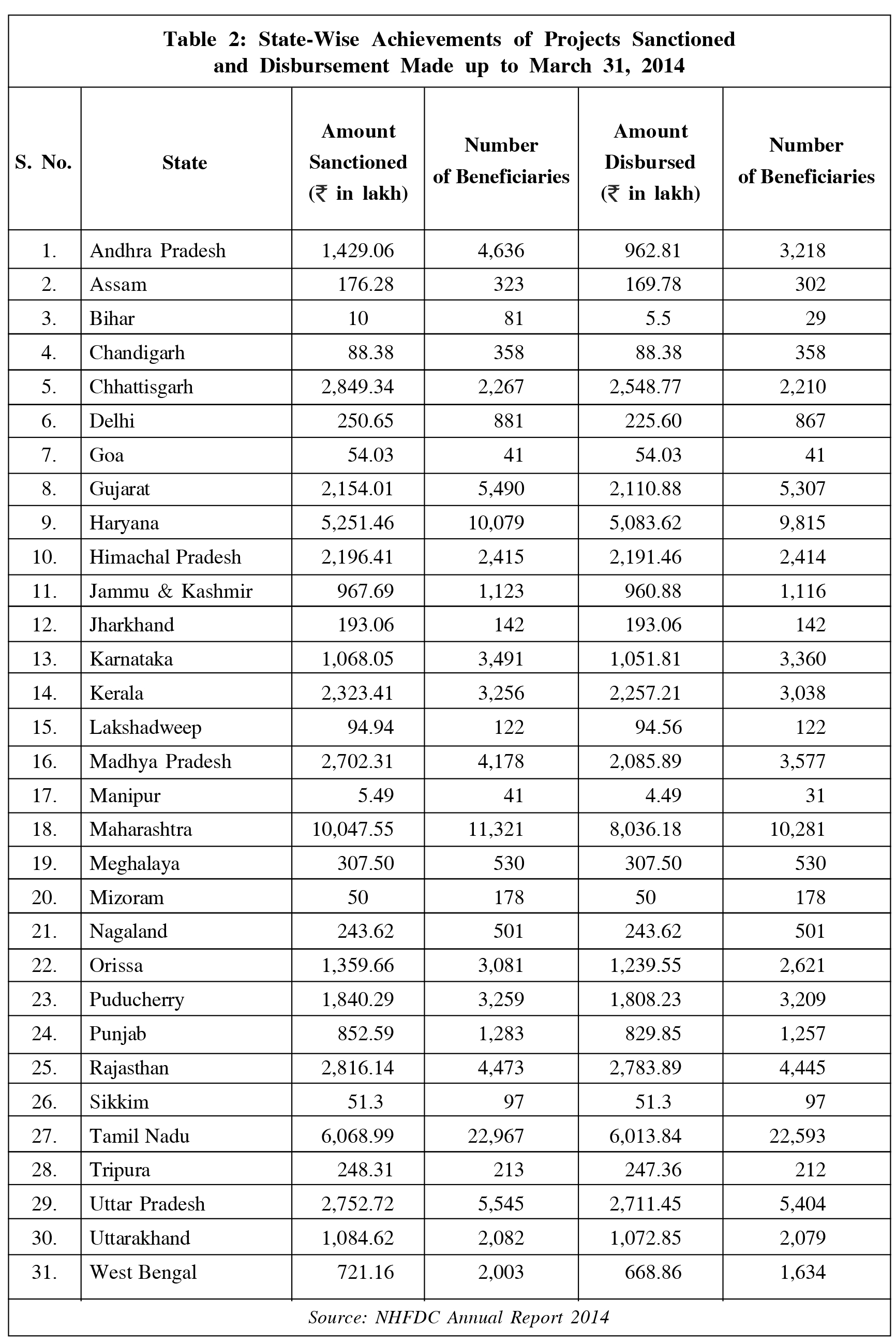
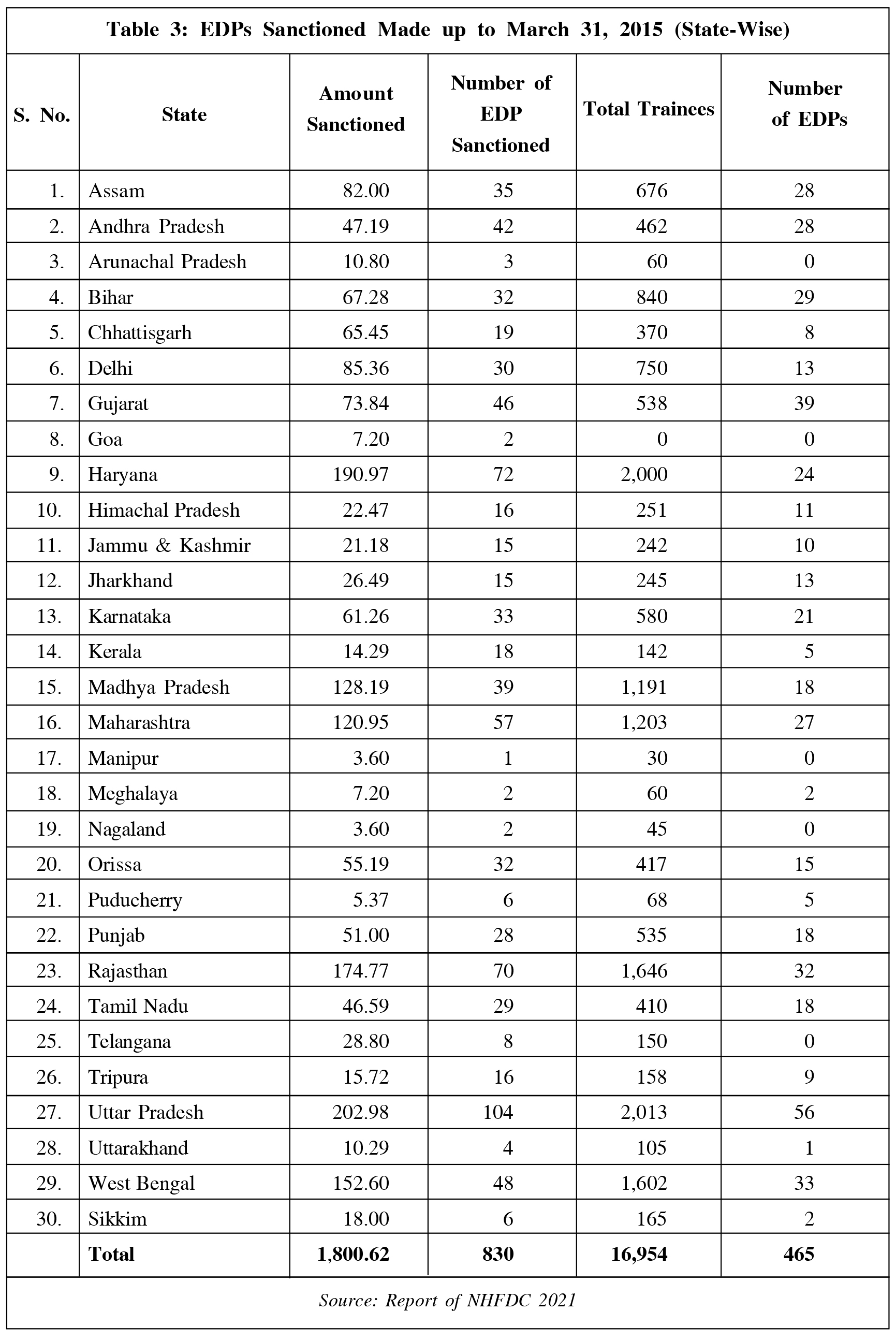
training section and the number of beneficiaries was 30. Total amount sanctioned for EDPs
up to the period of 2015 was only 1,800.62 lakh and the total number of programs constitute
465.
Summary
- NHFDC is conscious about quality enhancement through entrepreneurship development among differently abled persons.
- The corporation is focusing on quality skill development and providing special emphasis to attract persons with disabilities to skill and entrepreneurship development programs. An entrepreneur may not be able to succeed without entrepreneurial skills and qualities in the modern competitive market environment.
- The intended training facilities are being offered to the target group. Till date, the corporation has organized a number of entrepreneurship development programs and skill development trainings in all states covering a large number of differently abled persons.
- During the last 20 years, entrepreneurship development programs and skill development trainings were organized in all states covering thousands of persons with disabilities.
- The corporation assists the beneficiaries in participating in trade fairs and exhibitions at local, state, national and international levels through various market assistance schemes.
- The corporation provides the space for reimbursement for the cost of traveling and accommodation expenses and providing transportation cost of goods and daily allowances for the beneficiaries and escort for participation in these fairs.
- The beneficiaries are getting the chance of market opportunities through their participation in these events. Such participation also showcases the abilities of the differently abled to general public.
Conclusion
NHFDC is focusing on quality skill development for the wellbeing of differently abled
persons. It provides special emphasis to attract persons with disabilities to skill and
entrepreneurship development programs. A number of training facilities are offered to the
target group. Till date, the corporation has organized a number of entrepreneurship
development programs and skill development trainings in all states covering a large
number of differently abled persons. The corporation assists the beneficiaries in
participating in trade fairs and exhibitions at local, state, national and international levels
through various market assistance schemes. The corporation is mainly engaged in
financial assistance to differently abled persons with minimum 40% of disability under
microfinance schemes. NHFDC undertakes entrepreneurship development programs in
collaboration with nationalized banks and other specialized institutions. The financial support, the entrepreneurial development programs and various entrepreneurial skill development
programs are mainly conducted for the economic and social development of differently abled
persons.
References
- Lindsay Noel J, Wendy A and Kropp Fredric (2009), "Start-Up Intentions and Behavior of Necessity-Based Entrepreneurs: A Longitudinal Study", Frontier of Entrepreneurship Research, Vol. 29, No. 5, pp. 1-5.
- Rakesh Gupta and Pandit Ajay (2013), "Innovation and Growth of Small and Medium Enterprises: Role of Environmental Dynamism and Firm Resources as Moderating Variables", International Journal of Entrepreneurship and Innovation Management, Vol. 17, Nos. 4/5/6, pp. 284-295.
- Russell W Teasley, Richard B and Robinson (2005), "Modeling Knowledge-Based Entrepreneurship and Innovation in Japanese Organizations", International Journal of Entrepreneurship, Vol. 9, pp. 19-144.
- Saeed Saadat, Muffatto Moreno and Yousafzai Shumaila Y (2014), "Exploring Intergenerational Influence on Entrepreneurial Intention: The Mediating Role of Perceived Desirability and Perceived Feasibility", International Journal of Entrepreneurship and Innovation Management, Vol. 18, Nos. 2&3, pp. 134-153.